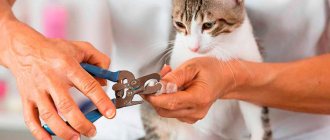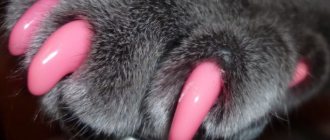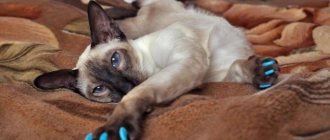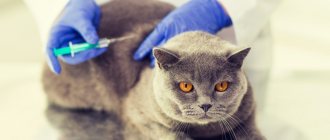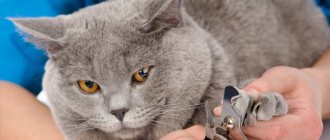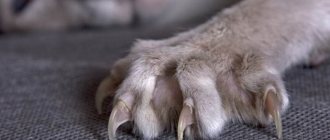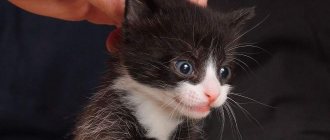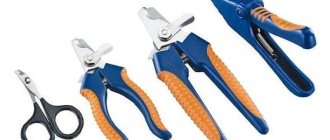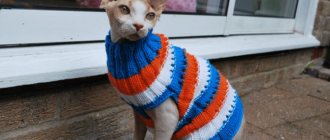Features of the operation
During this surgical operation, the claws are removed along with the entire terminal phalanx of the fingers. Veterinarians are mostly opposed to onychectomy. Considering the medical aspect, it should be noted that the removal of the phalanges of the fingers in cats is a very risky procedure: harm from general anesthesia, the risk of infection, and the risk of severe bleeding. If claws are removed incorrectly, the regeneration process may begin over time - the claws grow back, but very often they grow inside the foot, causing pain and suffering in the animal. There is a need for repeated declawing surgery to avoid extensive inflammation of the limbs.
Postoperative care
After surgery, the animal will require special care and attention. To alleviate the animal's suffering, repeated administration of painkillers will be required. To avoid infection of the wound, the sutures must be regularly treated with antiseptic agents. In addition, to prevent the cat from licking its wounds, it should wear a medical collar for two weeks. Three days after the operation, the doctor will examine the patient and give an opinion on the progress of the healing process.
Consequences of the operation
The consequences of the operation may include the following conditions:
- Severe blood loss with serious complications including death
- Loss of coordination due to the need to rely on the pads of the paws rather than on the toes
- Deterioration of gait and subsequent atrophy of the muscles of the limbs and back
- Regeneration of the claw and its ingrowth into the soft tissues of the foot, which leads to repeated surgery
- Long and painful healing process
Given the many risks and unintended consequences, Operation Soft Paws, as onychectomy is commonly called, is drawing protest from animal lovers. The European Convention protecting animal rights has banned onychectomy in many European countries. And even in those countries where this operation is permitted, such as in Russia, veterinarians are opposed to onychectomy.
After declawing, cats may develop arthritis due to the emphasis placed on the pads of their feet when walking. The muscles of the paws and back atrophy, coordination of movements is impaired. A cat that has experienced stress due to this inhumane operation feels completely defenseless, its character deteriorates, and it increasingly uses its last weapon of defense - its teeth.
Techniques
The procedure for declawing cats, no matter what method it is carried out, serves the same goals. Proponents of the operation often say that laser declawing of cats is now available without blood or negative consequences, but let's take a closer look, since these statements are not true.
Complete declawing of cats involves cutting off part of a finger, since the structure of the animal’s paws is much more complex than it seems (we discussed this above). When it comes to cutting off a fragment of a limb, one cannot do without stitches, the only alternative is a cauterizing cautery, which solders the edges of the skin. A solder is the same seam, but as if glued together, and not tied with thread.
So-called bloodless declawing of cats involves performing the procedure with a laser or a cauterizing cautery. This does not change the essence of the operation, there will be stitches, but the blood loss is really less, since the vessels are cauterized at the moment of dissection.
Relatively recently, an alternative to removing finger fragments has emerged - cutting the ligaments that respond to the movement of the claws. After the procedure, the animal simply cannot release its claws. The consequences of the operation are the same, but there are fewer complications. In addition, there is a high probability of ligament restoration, which means a repeat operation.
Caring for your cat after surgery
Caring for a cat after declawing involves increased attention, constant monitoring of the condition and the administration of painkillers throughout the entire rehabilitation period. The day after the operation, the cat must be shown to the doctor. If necessary, the surgeon tightens the stitches, always changes the bandage and treats the wounds. The bandages should be compressive and very strong, since there is a high probability that the cat will chew them.
At home, the tailed animal should always be kept in bandages and a surgical collar until the sutures are completely healed. Further, depending on the dynamics of recovery, sterile dressings are changed at least once every 4 days. Treatment of wounds is carried out during dressing . It is worth understanding that wounds hidden from air circulation heal more slowly and often become wet.
Important! When treating wounds, it is not recommended to use brilliant green and furatsilin, despite the fact that most veterinarians recommend them. When used regularly, these solutions burn the skin.
After tendon cutting surgery, care depends on the technique used. If the tendons were cut with a scalpel, the procedures are similar to those described above. If the surgeon used special forceps, pressure bandages or tourniquets are applied to each cat's paws, above the knee joints. After the cut, sutures are placed on the paws, which must be protected from the cat’s teeth and regularly treated with disinfecting solutions. The most commonly used is a surgical collar.
Arguments of supporters of onychectomy
Despite protests from animal rights activists, declawing cats has become fashionable in many countries around the world at some point. Proponents of this operation believe that it is completely safe for the health of the animal. Because declawing occurs under general anesthesia, they say, the cat experiences no pain. Cats begin to walk normally after 5-7 days.
Private veterinary clinics advertise onychectomy, and it becomes one of their areas of activity. Often the operation is performed at home if the cat owner arranges a call to a veterinary surgeon, not wanting to take the animal to the clinic. In this case, the cost of declawing is slightly increased compared to the cost of surgery in a hospital.
Private veterinary services usually warn that declawing can only be performed on cats that are constantly kept at home. If the owners plan to take their pets to the dacha in the summer, where they can come into contact with other animals, then this operation cannot be carried out so that your cat does not remain defenseless against aggression from its own kind. For the same reason, onychectomy is not possible if your cat is outdoors.
Of course, after declawing, the cat will never again sharpen its claws on your furniture, sofas and armchairs will remain intact, and no one will scratch your hands. Therefore, declawing cats is the price for your peace of mind. If you decide to have this operation, then you need to take into account that it is best to carry it out at an early age, then the cat will quickly get used to walking without claws. You can remove claws either on the front paws only, or on all four. After the operation, it is necessary to put a special collar on the cat for two weeks so that it does not remove the bandages from its paws and does not lick the wounds.
And these days, such questions as pros and cons, opinions of specialists and owners and many others related to the onychectomy operation cause fierce debate between its supporters and opponents. Remember, this little creature that you brought into the house is completely in your power, and you simply must create all the conditions for its normal development and good health. After all, you are responsible for him.
Caring for a cat after declawing surgery (soft paws)
Having decided to have surgery and having completed it, be prepared to care for your pet. The rehabilitation period can vary in length. It depends on how the cat underwent the operation, the professionalism of the doctors and your care.
Immediately after surgery, the cat will most likely sleep. Doctors warn that the cat may pee under itself, don’t be alarmed, he simply cannot recover from the anesthesia.
For the first few days, the cat will not be able to walk normally and may experience pain in the joints and back. Make sure she doesn't fiddle with the bandage; you can put on a special “Elizabethan” collar to hold it. The seams will need to be treated every day.
IMPORTANT: Try to reduce the distances your pet will have to travel - place the tray, bowl and bed as close as possible. You may need to change the litter if the last one was too hard.
You will have to forget about going outside and taking walks - there is a high probability of infection, and the cat has become too defenseless for the “harsh” streets.
Where can they remove claws and how much does it cost?
Not all clinics provide onychectomy, and prices for declawing are quite high. However, everywhere they offer a less radical alternative - nail trimming, which costs from 200 to 500 rubles , depending on the clinic, the cost may vary. In addition, another alternative has recently become widespread - silicone pads. As you can see in the photo, they are put on the claws and last from 3 to 5 weeks.
You need to know that declawing surgery is carried out strictly only for domestic animals, because while walking on the street, the cat will not be able to protect itself in case of danger, or simply climb a tree if attacked by a dog. If you
After all, we definitely decided that the cost of declawing cats ranges from 1,500 to 4,000 rubles. But currently, many animal protection organizations are fighting to ban declawing in Russia, and many veterinary clinics refuse to do it. In any case, before deciding on such an intervention in the life of an animal, you should think carefully.
Mr. Cat warns: complications of onychectomy
The advantages of this method of declawing are that the animal will not damage expensive furniture, wallpaper, curtains and other property and will not scratch the owner and his family members. However, the operation implies a high risk of complications for the cat’s health:
- Allergy to anesthesia, which can lead to the death of the pet.
- Yellow discharge from the wound, which may be the result of infection.
- Blood poisoning.
- Decreased immunity.
- Impaired movement coordination.
- Changes in posture, curvature of the spine.
- Loss of dexterity, decreased balance.
- Pain when walking due to a damaged nerve.
- Weakening of the back muscles.
- Dysbacteriosis due to prescribed antibiotics.
- Formation of calluses behind the pads.
- Hypersensitivity, in which it is very painful for the animal to get up.
You should constantly examine the cat’s paws, monitor whether lameness has appeared, and if complications are detected, immediately contact a veterinary clinic.
The disadvantages are that the animal’s psyche is traumatized, the cat stops playing as before, becomes fearful, withdrawn, and aggressive. Those pets that have not been neutered often “mark their territory.” In European countries, such an operation is illegal, but in America it is widely used.
Alternative
In order for everything in the house to remain in its original form, you should simply wean the cat from sharpening its claws on household objects. To do this, you can purchase a scratching post or make one yourself, building a whole play complex for your beloved pet. The main thing is not to put it off for a long time - it is very difficult to retrain an animal that is already accustomed to sharpening its claws on a soft sofa or a wooden chair leg. In addition, there are special silicone claw covers for animals that refuse to be trained.
The only thing to remember in this situation is that the pads need to be changed monthly.
The best way is to trim the tips of your nails. A more gentle method than surgery is to trim the tips of the claws with special tweezers. Pet owners who are inexperienced in this procedure should be extremely careful. It is preferable to contact a veterinarian so that he can show you how far the claws can be cut. After all, they contain blood vessels, which during the process of circumcision can be damaged and cause in the poor animal not only fear of such a procedure, but bleeding and inflammatory processes.
Feedback from pet owners
Vita Trushechkina
But I no longer doubt it. I already decided, today, after the cats went crazy, ran around like crazy and scratched our 9 month old daughter who was sitting playing on the floor. I'm not even talking about how scared she was. And yesterday I saw how one of the cats wanted to hit my daughter, but saw me and ran away. So I won't wait for them to claw her eyes out. I love our cats, but the child and his safety are more important.
Svetlana Skibenko
I'm sorry, but why are we talking only about sofas? Let's talk about the hostess's health! My cat is very affectionate and peaceful, he has been in our family since two months and has seen only tenderness - he is our favorite. But sometimes he has attacks of aggression or fear (for example, he was afraid of a working food processor) - he attacks me, his mistress. He has already repeatedly torn my legs to pieces, a couple of times even the ambulance took me away. The doctors advised me to get rid of the cat, but, again, I love him very much and don’t want to part with him. But I am still constantly afraid of his attacks. My legs are covered in terrible scars and in the summer I can’t even go to the beach! Moreover, this threatens blood poisoning. So what should I do - sacrifice the cat or is it better to use his claws?!
Jennifer
We declawed our cat. And it was a damn good decision. While all the wallpaper in our house was torn, shreds of carpets flew in all directions, etc. I endured it, trimmed the cat’s claws, ran after him with a scratching post, and so on. He sneezed on me and all my efforts. But when he with his claws jumped onto the hanger where my expensive leather jacket from Italy and my husband’s equally expensive sheepskin coat were hanging…. and, clinging to the jacket with one paw and the sheepskin coat with the other, he slid down, tearing shreds out of our clothes - this was the last straw. He was given general anesthesia and only the claws on his front paws were carefully removed. A week later he was jumping around like a saiga.
